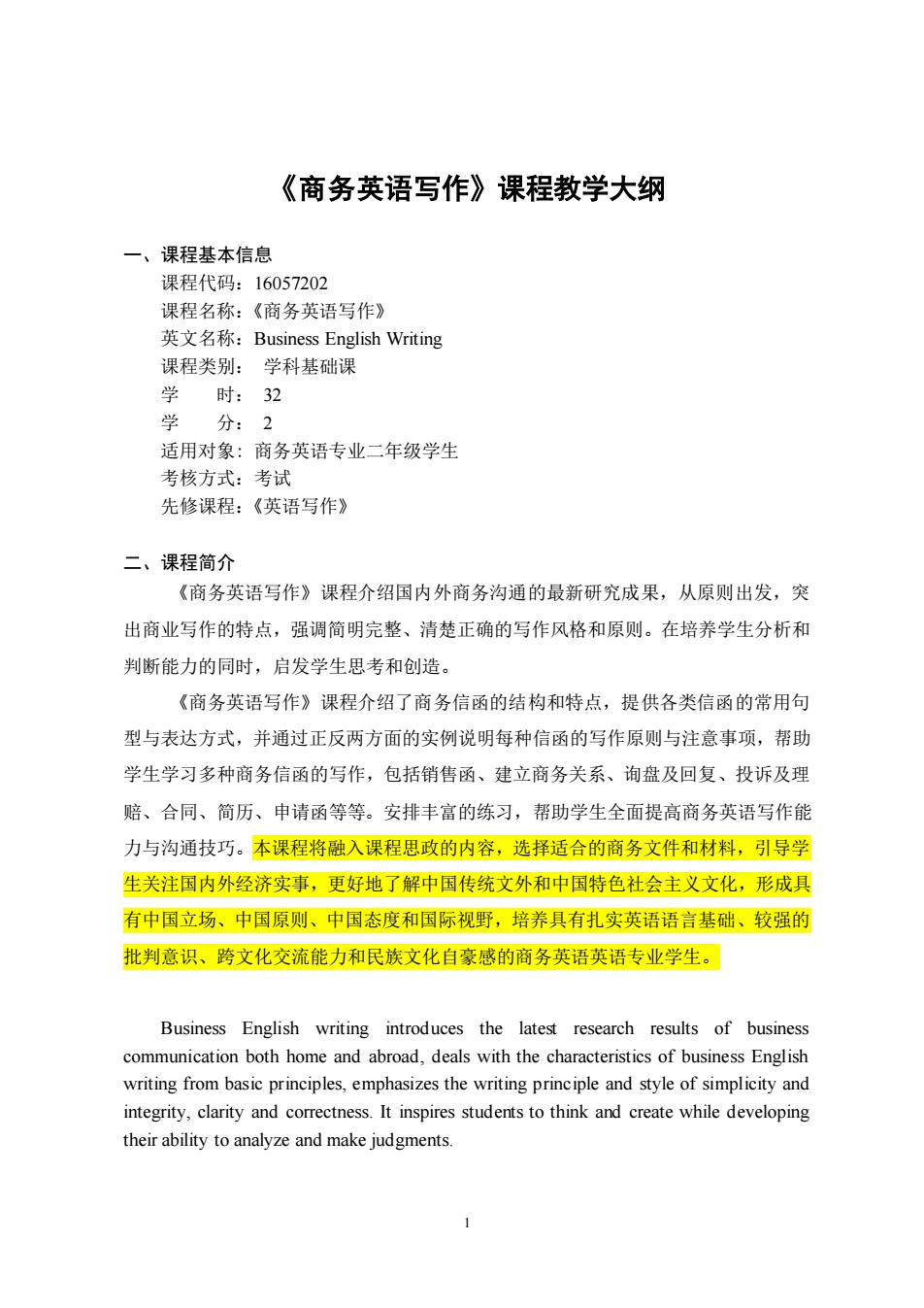
《商务英语写作》课程教学大纲 一、课程基本信息 课程代码:16057202 课程名称:《商务英语写作》 英文名称:Business English Writing 课程类别:学科基础课 时:32 学 分:2 适用对象:商务英语专业二年级学生 考核方式:考试 先修课程:《英语写作》 二、课程简介 《商务英语写作》课程介绍国内外商务沟通的最新研究成果,从原则出发,突 出商业写作的特点,强调简明完整、清楚正确的写作风格和原则。在培养学生分析和 判断能力的同时,启发学生思考和创造。 《商务英语写作》课程介绍了商务信函的结构和特点,提供各类信函的常用句 型与表达方式,并通过正反两方面的实例说明每种信函的写作原则与注意事项,帮助 学生学习多种商务信函的写作,包括销售函、建立商务关系、询盘及回复、投诉及理 赔、合同、简历、申请函等等。安排丰富的练习,帮助学生全面提高商务英语写作能 力与沟通技巧。本课程将融入课程思政的内容,选择适合的商务文件和材料,引导学 生关注国内外经济实事,更好地了解中国传统文外和中国特色社会主义文化,形成具 有中国立场、中国原则、中国态度和国际视野,培养具有扎实英语语言基础、较强的 批判意识、跨文化交流能力和民族文化自豪感的商务英语英语专业学生。 Business English writing introduces the latest research results of business communication both home and abroad.deals with the characteristics of business English writing from basic principles,emphasizes the writing principle and style of simplicity and integrity,clarity and correctness.It inspires students to think and create while developing their ability to analyze and make judgments. 1
1 《商务英语写作》课程教学大纲 一、课程基本信息 课程代码:16057202 课程名称:《商务英语写作》 英文名称:Business English Writing 课程类别: 学科基础课 学 时: 32 学 分: 2 适用对象: 商务英语专业二年级学生 考核方式:考试 先修课程:《英语写作》 二、课程简介 《商务英语写作》课程介绍国内外商务沟通的最新研究成果,从原则出发,突 出商业写作的特点,强调简明完整、清楚正确的写作风格和原则。在培养学生分析和 判断能力的同时,启发学生思考和创造。 《商务英语写作》课程介绍了商务信函的结构和特点,提供各类信函的常用句 型与表达方式,并通过正反两方面的实例说明每种信函的写作原则与注意事项,帮助 学生学习多种商务信函的写作,包括销售函、建立商务关系、询盘及回复、投诉及理 赔、合同、简历、申请函等等。安排丰富的练习,帮助学生全面提高商务英语写作能 力与沟通技巧。本课程将融入课程思政的内容,选择适合的商务文件和材料,引导学 生关注国内外经济实事,更好地了解中国传统文外和中国特色社会主义文化,形成具 有中国立场、中国原则、中国态度和国际视野,培养具有扎实英语语言基础、较强的 批判意识、跨文化交流能力和民族文化自豪感的商务英语英语专业学生。 Business English writing introduces the latest research results of business communication both home and abroad, deals with the characteristics of business English writing from basic principles, emphasizes the writing principle and style of simplicity and integrity, clarity and correctness. It inspires students to think and create while developing their ability to analyze and make judgments
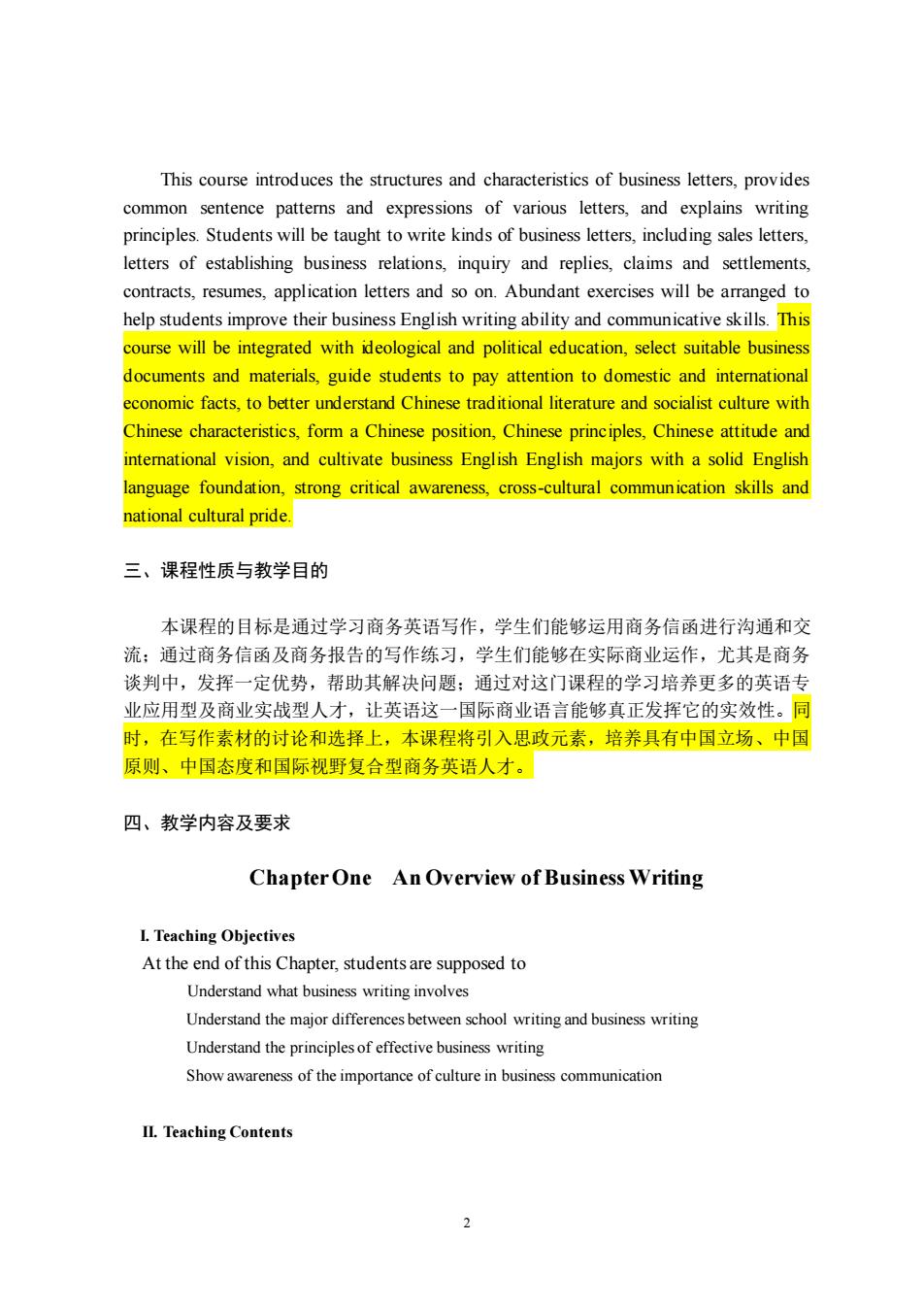
This course introduces the structures and characteristics of business letters,provides common sentence patterns and expressions of various letters,and explains writing principles.Students will be taught to write kinds of business letters,including sales letters, letters of establishing business relations,inquiry and replies,claims and settlements contracts,resumes,application letters and so on.Abundant exercises will be arranged to help students improve their business English writing ability and communicative skills.This course will be integrated with deological and political education,select suitable busines documents and materials.guide students to pay attention to domestic and internationa economic facts,to better understand Chinese traditional literature and socialist culture with Chinese characteristics,form a Chinese position,Chinese principles,Chinese attitude and ntemational vision.and cultivate business EnglishEnglish majors with a solid English language foundation,strong critical awareness,cross-cultural communication skills and national cultural pride 三、课程性质与教学目的 本课程的目标是通过学习商务英语写作,学生们能够运用商务信函进行沟通和交 流:通过商务信函及商务报告的写作练习,学生们能够在实际商业运作,尤其是商务 谈判中,发挥一定优势,帮助其解决问题:通过对这门课程的学习培养更多的英语专 业应用型及商业实战型人才,让英语这一国际商业语言能够真正发挥它的实效性。同 时,在写作素材的讨论和选择上,本课程将引入思政元素,培养具有中国立场、中国 原则、中国态度和国际视野复合型商务英语人才。 四、教学内容及要求 Chapter One An Overview of Business Writing LTeaching Objectives At the end of this Chapter,students are supposed to Understand what business writing involves Understand the major differences between school writing and business writing Understand the effective business writing Show awareness of the importance of culture in business communication II.Teaching Contents
2 This course introduces the structures and characteristics of business letters, provides common sentence patterns and expressions of various letters, and explains writing principles. Students will be taught to write kinds of business letters, including sales letters, letters of establishing business relations, inquiry and replies, claims and settlements, contracts, resumes, application letters and so on. Abundant exercises will be arranged to help students improve their business English writing ability and communicative skills. This course will be integrated with ideological and political education, select suitable business documents and materials, guide students to pay attention to domestic and international economic facts, to better understand Chinese traditional literature and socialist culture with Chinese characteristics, form a Chinese position, Chinese principles, Chinese attitude and international vision, and cultivate business English English majors with a solid English language foundation, strong critical awareness, cross-cultural communication skills and national cultural pride. 三、课程性质与教学目的 本课程的目标是通过学习商务英语写作,学生们能够运用商务信函进行沟通和交 流;通过商务信函及商务报告的写作练习,学生们能够在实际商业运作,尤其是商务 谈判中,发挥一定优势,帮助其解决问题;通过对这门课程的学习培养更多的英语专 业应用型及商业实战型人才,让英语这一国际商业语言能够真正发挥它的实效性。同 时,在写作素材的讨论和选择上,本课程将引入思政元素,培养具有中国立场、中国 原则、中国态度和国际视野复合型商务英语人才。 四、教学内容及要求 Chapter One An Overview of Business Writing I. Teaching Objectives At the end of this Chapter, students are supposed to Understand what business writing involves Understand the major differences between school writing and business writing Understand the principles of effective business writing Show awareness of the importance of culture in business communication II. Teaching Contents
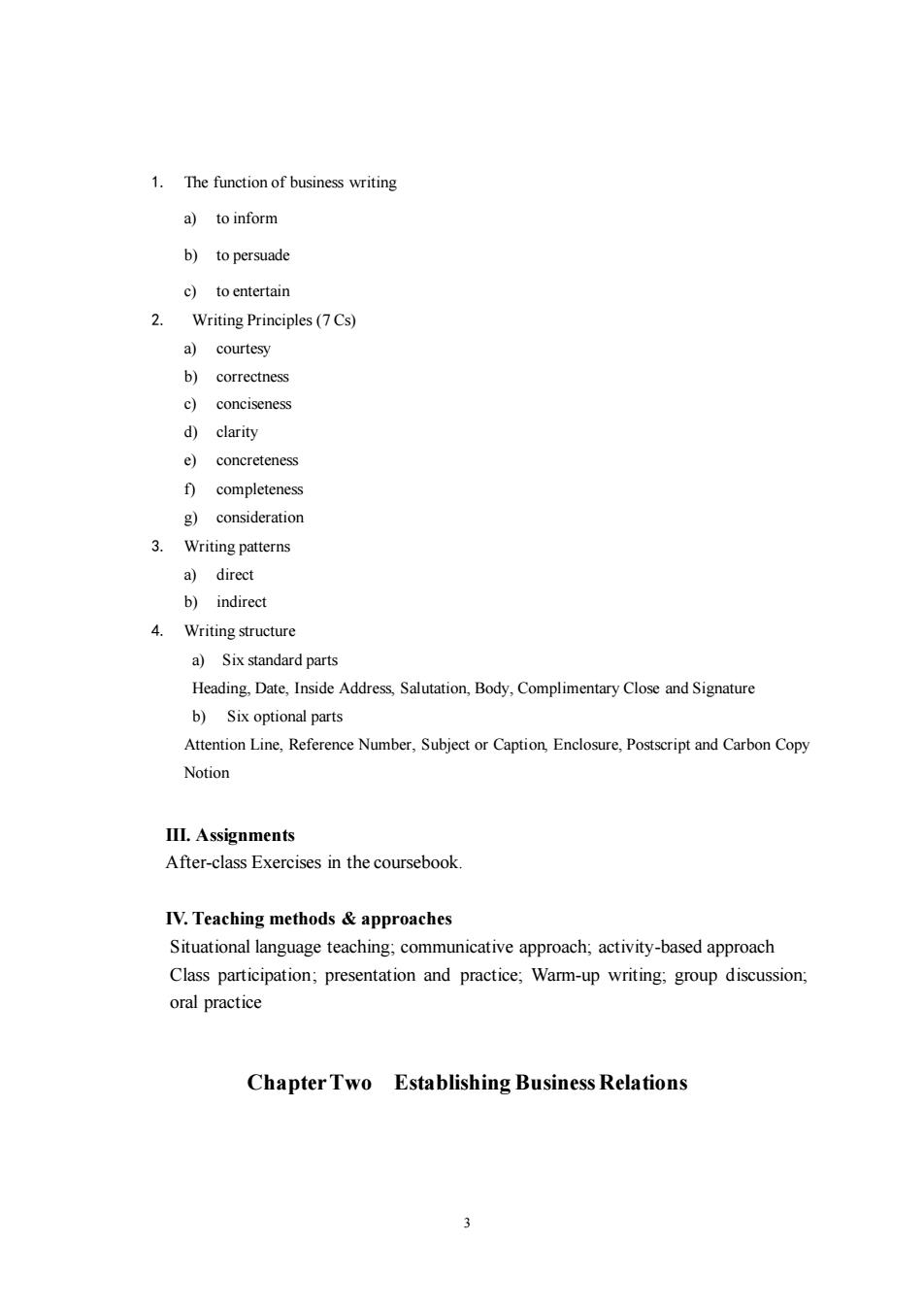
1.The function of business writing a)to inform b)to persuade c)to entertain 2. Writing Principles(7Cs) a)courtesy b)correctness c)conciseness d)clarity e)concreteness f)completeness g)consideration 3.Writing patterns a)direct b)indirect 4.Writing structure a)Six standard parts Heading.Date.Inside Address.Salutation.Body.Complimentary Close and Signature b)Six optional parts Attention Line,Reference Number,Subject or Caption,Enclosure,Postscript and Carbon Copy Notion III.Assignments After-class Exercises in the coursebook IV.Teaching methods approaches Situational language teaching:communicative approach;activity-based approach Class participation;presentation and practice,Warm-up writing;group discussion. oral practice ChapterTwo Establishing Business Relations 3
3 1. The function of business writing a) to inform b) to persuade c) to entertain 2. Writing Principles (7 Cs) a) courtesy b) correctness c) conciseness d) clarity e) concreteness f) completeness g) consideration 3. Writing patterns a) direct b) indirect 4. Writing structure a) Six standard parts Heading, Date, Inside Address, Salutation, Body, Complimentary Close and Signature b) Six optional parts Attention Line, Reference Number, Subject or Caption, Enclosure, Postscript and Carbon Copy Notion III. Assignments After-class Exercises in the coursebook. IV. Teaching methods & approaches Situational language teaching; communicative approach; activity-based approach Class participation; presentation and practice; Warm-up writing; group discussion; oral practice Chapter Two Establishing Business Relations
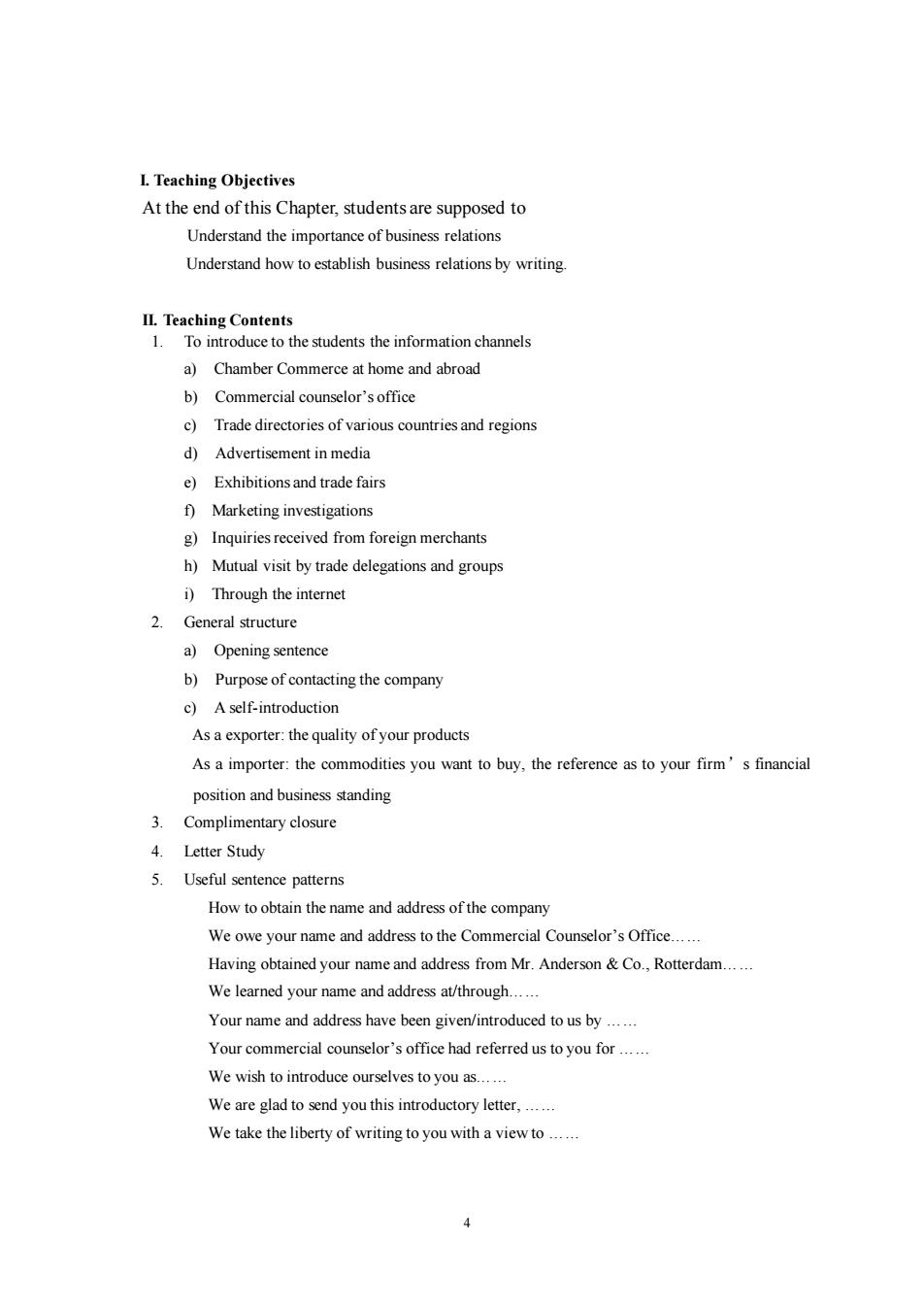
L.Teaching Obiectives At the end of this Chapter,students are supposed to Understand the importance of business relations Understand how to establish business relations by writing. II.Teaching Contents 1.To introduce to the students the information channels a)Chamber Commerce at home and abroad b)Commercial counselor'soffice c)Trade directories of various countries and region d)Advertisement in media e)Exhibitionsand trade fairs f)Marketing investigations g)Inquiriesreceived from foreign merchants h)Mutual visit by trade delegations and groups i)Through the internet 2.General structure a)Opening sentence b)Purpose of contacting the company c)Aself-introduction As a exporter:the quality of your products As a importer:the commodities you want to buy,the reference as to your firm's financial position and business standing 3.Complimentary closure 4.Letter Study 5.Useful sentence patterns How to obtain the name and address of the company We owe your name and address to the Commercial Counselor's Office. Having obtained your name and address from Mr.Anderson&Co.,Rotterdam... We learned your name and address at/through. Your name and address have been given/introduced to us by Your commercial counselor's office had referred us to you for We wish to introduce ourselves to you as.. We are glad to send you this introductory letter. We take the liberty of writing to you with a view to
4 I. Teaching Objectives At the end of this Chapter, students are supposed to Understand the importance of business relations Understand how to establish business relations by writing. II. Teaching Contents 1. To introduce to the students the information channels a) Chamber Commerce at home and abroad b) Commercial counselor’s office c) Trade directories of various countries and regions d) Advertisement in media e) Exhibitions and trade fairs f) Marketing investigations g) Inquiries received from foreign merchants h) Mutual visit by trade delegations and groups i) Through the internet 2. General structure a) Opening sentence b) Purpose of contacting the company c) A self-introduction As a exporter: the quality of your products As a importer: the commodities you want to buy, the reference as to your firm’s financial position and business standing 3. Complimentary closure 4. Letter Study 5. Useful sentence patterns How to obtain the name and address of the company We owe your name and address to the Commercial Counselor’s Office…… Having obtained your name and address from Mr. Anderson & Co., Rotterdam…… We learned your name and address at/through…… Your name and address have been given/introduced to us by …… Your commercial counselor’s office had referred us to you for …… We wish to introduce ourselves to you as…… We are glad to send you this introductory letter, …… We take the liberty of writing to you with a view to ……
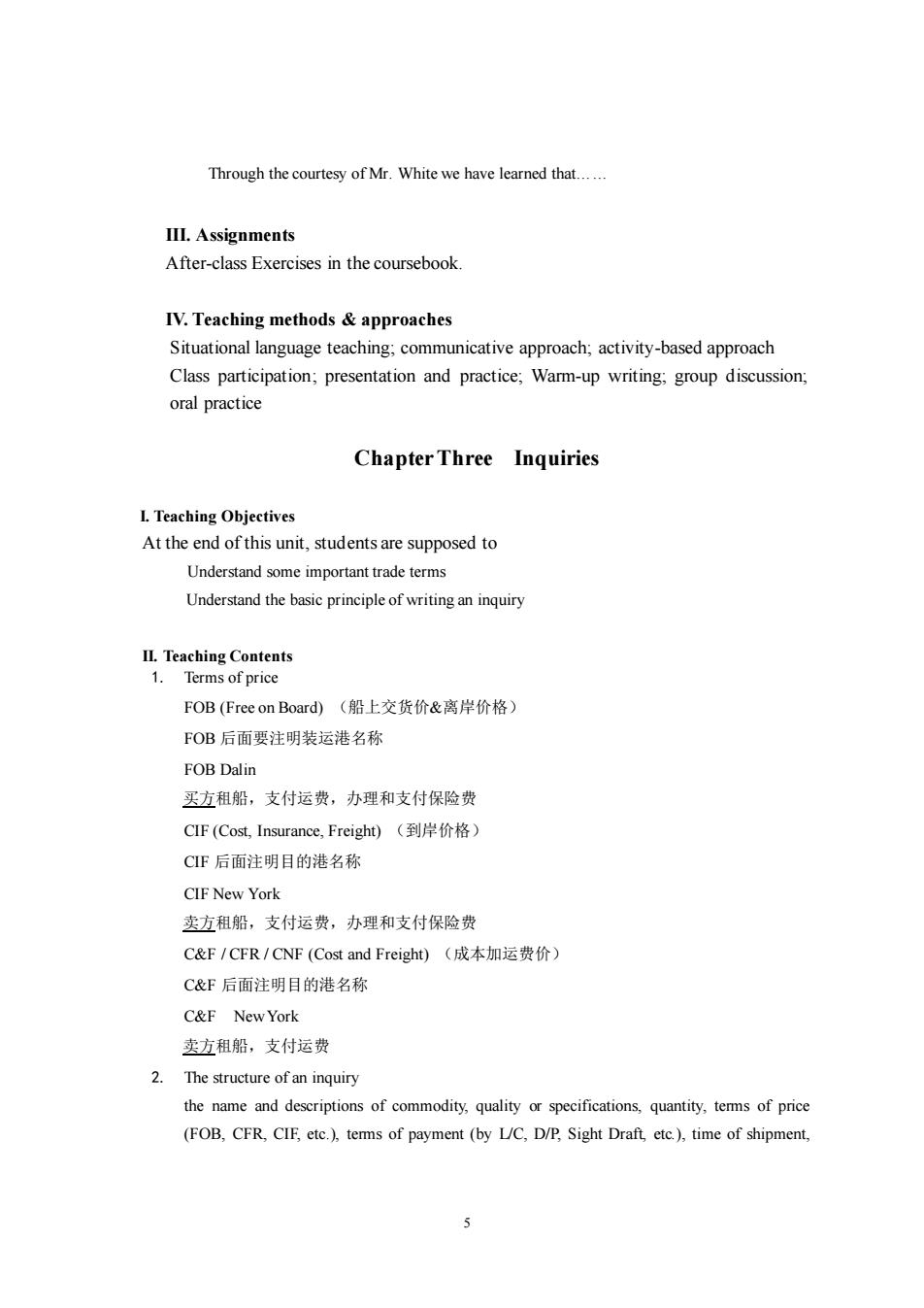
Through the courtesy of Mr.White we have learned that III.Assignments After-class Exercises in the coursebook IV.Teaching methods approaches Situational language teaching:communicative approach;activity-based approach Class participation;presentation and practice,Warm-up writing;group discussion. oral practice ChapterThree Inquiries LTeaching Objective At the end ofthis unit,students are supposed to Understand some important trade terms Understand the basic principle of writing an inquiry II.Teaching Contents 1.Terms of price FOB(Freeon Board))(船上交货价&离岸价格 FOB后面要注明装运港名称 FOB Dalin 买方租船,支付运费,办理和支付保险费 CIF(Cost,Insurance,.Freight)(到岸价格) CF后面注明目的港名称 CIF New York 卖方租船,支付运费,办理和支付保险费 C&F/CFR/CNF(Cost and Freight)(成本加运费价) C&F后面注明目的港名称 C&F New York 卖方租船,支付运费 2.The structure of an inquiry the name and descriptions of commodity.qualityor specifications,quantity,tems of price (FOB,CFR.CIF,etc.)temms of payment (by LC.D/P Sight Draft etc),time of shipment 5
5 Through the courtesy of Mr. White we have learned that…… III. Assignments After-class Exercises in the coursebook. IV. Teaching methods & approaches Situational language teaching; communicative approach; activity-based approach Class participation; presentation and practice; Warm-up writing; group discussion; oral practice Chapter Three Inquiries I. Teaching Objectives At the end of this unit, students are supposed to Understand some important trade terms Understand the basic principle of writing an inquiry II. Teaching Contents 1. Terms of price FOB (Free on Board) (船上交货价&离岸价格) FOB 后面要注明装运港名称 FOB Dalin 买方租船,支付运费,办理和支付保险费 CIF (Cost, Insurance, Freight) (到岸价格) CIF 后面注明目的港名称 CIF New York 卖方租船,支付运费,办理和支付保险费 C&F / CFR / CNF (Cost and Freight) (成本加运费价) C&F 后面注明目的港名称 C&F New York 卖方租船,支付运费 2. The structure of an inquiry the name and descriptions of commodity, quality or specifications, quantity, terms of price (FOB, CFR, CIF, etc.), terms of payment (by L/C, D/P, Sight Draft, etc.), time of shipment